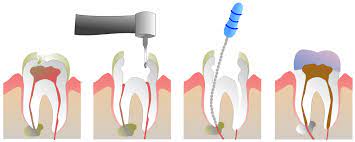Uncover the truth about root canal treatment and learn why it is necessary for dental health.
Understanding the basics of root canal treatment
Root canal treatment, also known as endodontic therapy, is a dental procedure used to treat and save a severely damaged or infected tooth. It involves removing the infected pulp from the inside of the tooth, cleaning and disinfecting the root canals, and then filling and sealing them to prevent further infection.
The pulp, located in the center of the tooth, contains nerves, blood vessels, and connective tissue. When the pulp becomes infected or damaged due to tooth decay, trauma, or deep dental fillings, a root canal treatment is necessary to remove the infection and preserve the tooth.
Root canal treatment is typically performed by an endodontist, a dental specialist who specializes in treating the inside of the tooth. The procedure is done under local anesthesia to ensure a pain-free experience for the patient.
Signs that indicate the need for a root canal
There are several signs that may indicate the need for a root canal treatment. These include:
1. Severe toothache: A persistent and intense toothache is often a sign of an infected tooth pulp.
2. Sensitivity to hot and cold: If you experience extreme sensitivity to hot and cold temperatures, it could be a sign of a damaged pulp.
3. Swollen gums: Swelling and tenderness in the gums around the affected tooth may indicate an infection.
4. Discolored tooth: A tooth that has become darkened or discolored may indicate a dying pulp.
5. Deep dental decay: Extensive tooth decay that has reached the pulp may require a root canal treatment.
If you experience any of these signs, it is important to visit a dentist or endodontist for an evaluation and appropriate treatment.
Step-by-step process of a root canal treatment
A root canal treatment typically involves the following steps:
1. Examination and X-rays: The dentist or endodontist will examine the affected tooth and may take X-rays to determine the extent of the infection and damage.
2. Local anesthesia: Local anesthesia is administered to numb the area around the tooth and ensure a pain-free procedure.
3. Accessing the pulp: The dentist will create a small access hole in the tooth to reach the infected pulp and root canals.
4. Removing the infected pulp: Using specialized dental instruments, the dentist will carefully remove the infected pulp from the tooth and clean the root canals.
5. Disinfecting and shaping the canals: The root canals are thoroughly cleaned and shaped to remove any remaining bacteria and ensure a proper seal.
6. Filling and sealing the canals: The cleaned canals are filled with a rubber-like material called gutta-percha, and a temporary filling is placed on top.
7. Restoring the tooth: In most cases, a dental crown is placed on the treated tooth to protect and strengthen it.
Root canal treatment may require multiple appointments, depending on the complexity of the case. After the final appointment, the tooth should function and feel like a natural tooth.
Common misconceptions about root canal treatment
Despite its effectiveness and importance in preserving teeth, root canal treatment is often surrounded by misconceptions. Let's debunk some common myths:
1. Myth: Root canal treatment is painful. Fact: With modern anesthesia and techniques, root canal treatment is no more painful than getting a dental filling.
2. Myth: It's better to extract the tooth. Fact: Saving the natural tooth through root canal treatment is usually the best option for long-term oral health.
3. Myth: Root canal treatment causes illness. Fact: There is no scientific evidence linking root canal treatment to systemic illnesses.
4. Myth: Root canal treatment is not necessary if there is no pain. Fact: Not all root canal infections cause pain, and delaying treatment can lead to more severe complications.
It's important to rely on accurate information from dental professionals to make informed decisions about your oral health.
Tips for a successful recovery after root canal treatment
After a root canal treatment, it is important to take care of your tooth and support the healing process. Here are some tips for a successful recovery:
1. Take prescribed medications: Follow the dentist's instructions and take any prescribed antibiotics or pain medications as directed.
2. Avoid chewing on the treated tooth: To prevent any damage or dislodging of the temporary filling or crown, avoid chewing on the treated tooth until the final restoration is complete.
3. Practice good oral hygiene: Continue to brush and floss your teeth regularly, paying extra attention to the treated tooth.
4. Attend follow-up appointments: It is essential to attend any scheduled follow-up appointments to ensure proper healing and assess the success of the treatment.
By following these tips and maintaining regular dental visits, you can ensure the long-term success of your root canal treatment.


